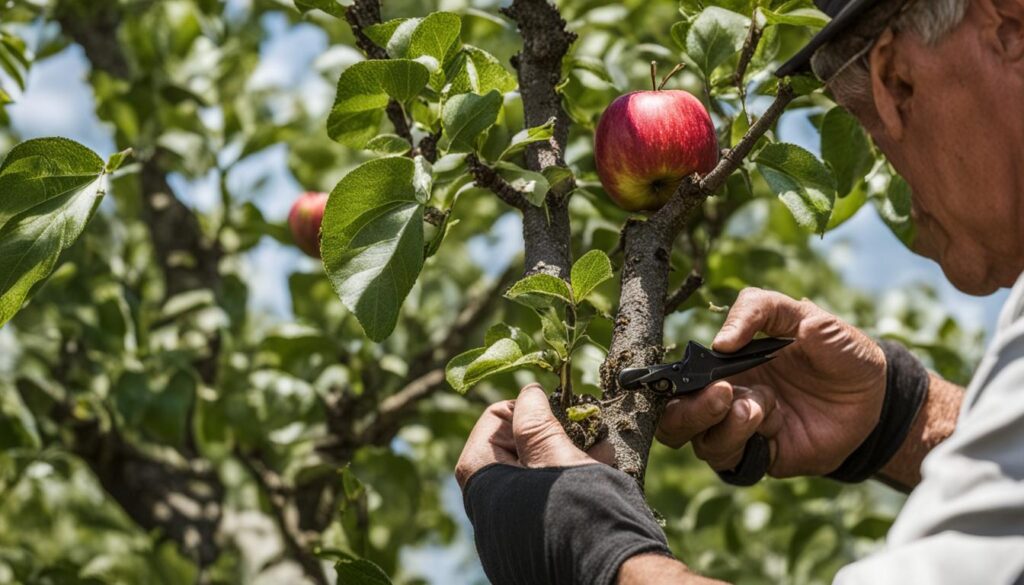Welcome to the fascinating world of apple trees! Whether you’re a gardener, farmer, or simply an apple enthusiast, knowing the life cycle of an apple tree can deepen your appreciation for these remarkable plants. From seed germination to fruit-bearing maturity, each stage in their life is a testament to the wonders of nature.
It all begins with the planting of apple seeds and the nurturing power of sunlight and water. As the seeds sprout, tiny roots take hold, paving the way for future growth. Over time, the tree emerges from the soil as sprouts, establishing a firm foundation for its journey ahead.
As the tree reaches adulthood, it enters the bud stage. Buds form and eventually blossom, creating a spectacle of vibrant flowers. These blossoms serve a vital purpose – they attract bees for pollination, a crucial step in the tree’s reproductive process. The fertilized blossoms then give way to apples, marking the onset of the fruit stage.
Awaiting the harvest, the apples take approximately 160-180 days to mature, thriving under the watchful eye of Mother Nature. Throughout this life cycle, the tree’s growth and fruit-bearing capacity are influenced by factors such as temperature, water, and sunlight.
As you embark on your journey to understand apple trees, let’s explore the importance of grafting in their growth in the next section, and uncover tips for successfully growing and caring for these remarkable trees in the following section. Shall we continue?
Importance of Grafting in Apple Tree Growth
Grafting plays a crucial role in the growth of apple trees, allowing farmers to control the apple variety and tree size. By using grafted saplings obtained from nurseries, farmers can ensure that their apple trees produce the desired apple varieties and grow to the preferred sizes. Grafting provides a reliable method to achieve uniformity and consistency in fruit production.
If apple trees are grown from seeds, there are no guarantees regarding the fruit quality or size. Additionally, it can take a considerable amount of time, typically 5 to 8 years, before seed-grown trees start bearing any fruit. This uncertainty and long waiting period can be avoided by opting for grafted trees.
Grafted trees, especially dwarf varieties, offer substantial advantages. These trees tend to produce fruit much sooner than seed-grown trees. In as little as 3 years after planting, grafted, dwarf apple trees can yield a bountiful harvest. This not only saves time but also allows farmers to enjoy the fruits of their labor more quickly.
Grafting provides greater control over the fruit production timeline, enabling farmers to plan and anticipate their yields. It also enhances the chances of successfully growing desired apple tree varieties, ensuring a higher chance of desired fruit production.
Overall, grafting offers numerous benefits in apple tree cultivation. It allows for the cultivation of specific apple tree varieties, controls tree size, and accelerates fruit production, promoting efficient and successful apple orchard management.
Tips for Growing and Caring for Apple Trees
When it comes to growing apple trees, proper care and attention are essential for their health and productivity. Follow these tips to ensure your apple trees thrive:
1. Choose the right tree size: Consider the available space and your needs before selecting a tree size. Dwarf, semi-dwarf, or standard-sized trees are available, allowing you to find the perfect fit for your garden.
2. Prune during the dormant stage: Pruning is crucial for shaping the tree and promoting better fruit production. During the dormant season, remove any dead or damaged branches, and thin out crowded areas to allow sunlight and air circulation.
3. Disease and Pest control: Regular inspection and control of diseases and pests are vital for the tree’s health. Identify common apple tree diseases such as apple scab, powdery mildew, and fire blight, and take appropriate measures to prevent or treat them. Use organic methods or recommended pesticides to protect your trees.
4. Fertilize and weed: Provide your apple trees with adequate nutrients by fertilizing them in the spring. Use a balanced fertilizer formulated specifically for fruit trees. Keep the area around the tree clear of weeds, as they compete for nutrients and water, affecting the tree’s growth.
5. Monitor health and irrigation: Regularly monitor the tree’s overall health, looking out for signs of stress or disease. Ensure the tree receives sufficient water, especially during dry spells, to keep it hydrated and healthy.
By following these tips for growing and caring for apple trees, you can enjoy a bountiful harvest and healthy, thriving trees all year round.
How Does the Apple Tree Life Cycle Impact Red Apple Ground Cover?
The apple tree life cycle significantly affects the vibrant red apple ground cover. From blossoms to fruit, the tree’s growth stages impact the ground cover’s appearance and health. The fallen red apples eventually decompose and nourish the soil, contributing to the cycle’s ongoing vitality.










